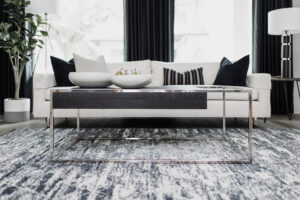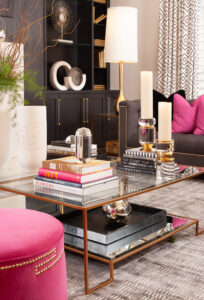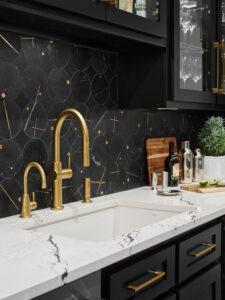All That Glitters: Decorating With Metal for Shining Interior Decor
It’s likely that most people’s minds don’t automatically jump to metal when it comes to interior design and decor. But, the truth is that metal is a severely (perhaps even criminally) underrated material to decorate with.
In this article, we’ll discuss metal’s numerous advantages as a decorative medium, which interior design styles it’s particularly well-suited for, different kinds of metal and metal accents, the best applications of metal in interior decorating and, finally, how Decorating Den Interiors can help you add a brilliant gleam to your home.
Metal Is the New Wood
Here are a few of the most notable benefits of decorating with metal:
Durability
Unlike softer materials that are prone to deterioration, metal is incredibly tough and can withstand a lot of wear and tear. Metal is forged in a way that allows it to last generations, and its only real threats are scratches and corrosion, although treatments and alloys typically prevent this.
Low maintenance
Many other substances require regular and sometimes complicated and expensive upkeep. For example, some types of wood need to be polished with very specific, pricey polishes. By contrast, metal rarely needs any care beyond the occasional buff. Because of its durability, it’s also much more resistant to breaking or shattering.
Affordability
Plenty of materials and fabrics can cost thousands of dollars. Think of genuine leather and suede, woods such as mahogany and ebony or stone like marble and limestone. Most metals (barring precious ones, e.g. gold and platinum) are much easier on the wallet. Their longevity also makes them a worthwhile investment.
Sustainability
Metal is a prime decorative choice if you’re concerned about sustainability. Of course, mining and processing does have a negative environmental impact. However, metal’s long lifespan means you likely won’t ever have to replace anything made from it, which negates much of its detrimental effect on the environment.
Naturally, it’s also greener than plastic and many other synthetic materials. Metal can also be recycled, meaning you can buy pieces made from repurposed metal which is even better for the natural world!
Adaptability
Metal is incredibly versatile and flexible. We don’t mean in a malleable or pliable way, of course — that would defeat one of its greatest selling points. Rather, it can often be repurposed many times over. For instance, outdoor metal art can be brought inside and vice versa. Or, you can paint your metal decor or furniture any color your heart desires rather than purchasing new pieces (this adds to its cost-effectiveness).
Metal for the Ages
Now, because you don’t see much metal in everyday interior design, you may be wondering which interior design styles it’s suited to. The answer? A whole bunch, including:
Industrial chic
As you might have guessed from the title, this type of interior design is all about mimicking industrial settings such as factories. So, it’s only natural that you’d see a lot of exposed beams, ducts and pipes, raw materials like bare brick and concrete and, obviously, metal.
Modernism
This design style is characterized by monochromatic palettes, clean and simple lines and lots of natural light and materials. It’s used because it’s essentially the opposite of the ornate, luxury woods seen in more traditional kinds of interior design.

Minimalism
Function over form is the order of the day in minimalism. Because metal is so versatile and easy to maintain, it’s a no-brainer that it would form an integral part of minimalist interior design.
Art deco
Art deco became extremely popular in the West during the 1930s. It’s all about luxury and glamor, so it stands to reason that gleaming metals would be prominent. You’ll find tons of ornate lamps and chandeliers, banisters and art.
Rustic
That’s quite the pun, but we’re not referring to rusted metal. You’ll see a lot of corrugated iron and tin in particular, especially in roofs but also as panels in accent walls. This makes a building designed in this style feel functional, much like a barn or tool shed.
Metal Subgenres
Not all equals are made (or should we say “forged”) equal. Some are better suited to certain applications than others. So, let’s take a look at a few popular types of metal and what they’re used for.
Steel
It’s important to note that “steel” is a catch-all term for many types of steel, namely stainless steel, alloy steel, carbon steel and tool steel. What makes them all different is how much carbon is added to the iron used to make them. It’s very strong, so it has a very wide range of uses, including backsplashes, accent walls, railings, light fixtures and furniture.
Brass
If you’re looking for a rust-resistant metal, this should be your go-to. It’s an alloy (combination) of copper and zinc, meaning it can be forged into many of the same items as copper. Brass is well-liked because of its shiny golden appearance. You’ll see it widely used in other decorations like candle holders, clocks, lamps and mirror frames.
Copper
Copper is exceptionally popular because it actually comes in a variety of colors. It has a salmon tone when unpolished and can become a turquoise or green shade over time due to oxidation. It’s most commonly used for fixtures like door handles, knobs and faucets.
Wrought-iron
This metal is made from pig iron, which has nothing to do with pork and everything to do with iron ore. The resulting material is incredibly strong and resistant to corrosion. It’s typically used for decorative fences and gates, chandeliers and dining chairs, especially outdoor furniture.
This dining set will stand up to the elements.
Bronze
Like brass, bronze is an alloy made from copper and tin. As you may know, a lot of artwork is made from brass. This is because it’s a smooth liquid in its molten state. The work you see containing bronze is often more intricate than that made of other metals.
Shiny New Toys
There are so many ways to incorporate metals into your home precisely because there are plenty of different types of metal.
Furniture
Perhaps quite obviously, one safe bet is furniture. Metals (particularly steel) make great table and chair legs. You’ll often see glass sheets atop metal tables because of the wonderfully clean and modern aesthetic this combination creates. It’s also a fantastic choice for sleek bed frames, especially four-poster beds.

As we mentioned, wrought iron is popular for pieces used in gardens because it’s very durable. Simple metal furniture can produce a striking look when combined with more ornate traditional items such as Persian rugs and crystal chandeliers.
Metal Wall Decor
You might envision an enormous tapestry, mural, miniature painting gallery or a single wall in a solid color when you hear “accent wall,” but using metal to create an accent wall is a beautifully unique and unconventional alternative.
This is typically achieved by installing a single sheet of metal or several panels. They may be solid or contain patterns that create a stark contrast when a natural wall is seen through the negative space.
Door Knobs, Handles and Knockers
It’s very rare that you’d encounter any of these made in a material other than metal. Owing to its strength, steel is ideal for door handles because it’s unlikely to break even if you have to use a considerable amount of elbow grease to open a jammed door.
Aluminum is also a good choice for doors leading into a home from the outside because it’s very rust-resistant. Brass is stunning and long-lasting, but be aware that it can corrode, and its color fades and changes with time. It’s also softer than some other metals, meaning it can be easily scratched and dented.
Simple metal knobs and handles can create a pleasing contrast when combined with luxuriously carved wooden doors. Conversely, an opulent knocker made from bronze or brass can pop out beautifully when paired with a simple monochromatic door.
Faucets
Stainless steel is a go-to material for faucets (especially in modernist kitchens and bathrooms) because its simple silver color looks sleek and elegant. Brass is popular because it’s rust-resistant and adds a gorgeous, stylish rose-gold gleam, which is ideal for interior design styles like Art Deco.
Copper is antimicrobial, which is helpful in rooms that need to stay sanitary and hygienic. But, its color will change, so it’s not recommended to use unless you’re ok with its hue shifting (or maybe that’s your goal). You won’t find many bronze faucets because they’re typically custom-made.
Art
Beyond canvas wall art and stone statues, we have artwork made from metal. They come in many shapes and forms, such as statuettes, large sculptures and metal wall art. That last one is a perfect choice if you want an art piece that strays off the beaten path. Don’t forget that wall mirrors can be their own form of art, and you don’t have to look too hard to find interesting and aesthetically pleasing ones!
Steel Your Nerves by Working With an Interior Designer
There’s no reason to fret if the idea of decorating with metal by yourself gives you cold feet. Decorating Den Interiors’ award-winning designers are here to help your decorating compass point due north. They can help you select the right metals and finishes, depending on what you want to do with them and what aesthetic you want to achieve.
After you’ve reached out to us, we’ll assign you your personal home decor expert who will meet with you to discuss your vision. Then, they’ll begin drawing up plans and showing you samples. They’ll start sourcing items and getting to work once you’ve signed off on their final designs.
They’ll be there every step of the way if you have any questions or concerns. Contact us today!



